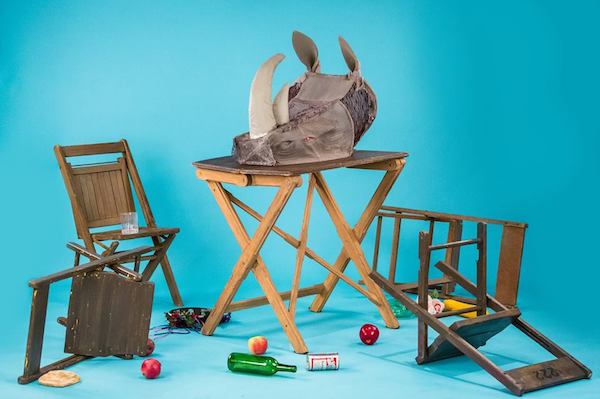
'Rhinoceros': It's so easy to follow the herd
By Steve Callahan
You're a normal middle-class minion working in a boring office job, too tired to hope, too lazy to kill yourself, drinking a little too much. And suddenly people start turning into rhinoceros. (Or is it rhinoceroses? Actually either is correct.)
The Webster Conservatory presented a lively, thought-provoking and very wild production of Eugène Ionesco's 1960 play, Rhinoceros. The French-Romanian Ionesco was one of the founding fathers of what has been called the "Theatre of the Absurd."
Poor Berenger! He just doesn't fit in. He's in love with Daisy, his office receptionist, but he hasn't the nerve to approach her. His best friend, Jean, constantly berates him for his slovenliness and his drinking. He's in trouble for always being late for work. Then . . . a rhinoceros thunders through the town square! Then another!! Can it be?
One of his office colleagues has, it seems, turned into a rhino. More and more people are being afflicted with "rhinoceritis"! Now the city is full of the awful beasts! Everybody's doing it! Everybody's joining the herd.
Ionesco was a young intellectual in Romania and saw his friends being drawn into the infamous bloodily nationalistic sect, the Iron Guard. He was a mature writer living in Paris during the Nazi occupation. His play, Rhinoceros, is a stiletto-sharp parody of mankind's innate herd instinct. We so need to join a tribe! We so readily fall in with the trending political fashion, be it on the left or on the right, no matter how irrational it may be, no matter what hideous moral beasts it may turn us into. One by one Berenger's friends yield to the urge to be like everybody else: a rhinoceros. They join the group with the most powerful, vital energy, no matter how destructive.
I commend director Max Friedman for choosing this play for his thesis project. It has such resonance after the recent political campaign, which resembled less an exercise in democracy than a trampling herd of monstrous beasts bent on destruction.
The set by Star Turner at first seemed a little under-decorated: a street scene, a sidewalk café, pale gray walls adorned with a few flowering vines from Michael's discount bin. But then we find that the walls are for projections -- strange, indeterminate moving images -- perhaps large animals. And the set is wonderfully flexible, serving, as it does, for other scenes: an office, Berenger's flat, Jean's flat.
The entire cast does excellent work. Their energy and pace sweep us along. Ian Erbe plays Berenger. Now Berenger is really something of a schlemiel, a downtrodden drudge, until his final stalwart stance defending humanist values. Mr. Erbe is a bit too much of a leading man type to totally convince us. (Gene Wilder played the role in the 1974 film.) But Erbe carries it off.
The dapper Jean was played in the film by Zero Mostel. In this Conservatory production the role is played by the gifted Annie Barbour. I would say that the lean and leggy Miss Barbour is perhaps the very antithesis of Zero Mostel. Who could be more different? I think there must be a clause in her contract stipulating that she be allowed to wear those long, Hollywood glamour slacks as she did in The Miser. However, the fact that she may be the only person in St. Louis who can effectively wear such things does not mean that they are appropriate for every role. And to see, through a scrim, the lovely Miss Barbour in her skivvies in a very strange, bloody rhino-transformation orgy is rather far from Ionesco's intention -- and also from Mostel's transformation, which used no makeup, no prosthetics, just Mostel. (Well, I guess he is a bit more like a rhino to begin with.)
I know that in educational productions there are many reasons to cast a woman in a man's role, but here, I think, it's hard to buy into the gender swap. (A minor point: With the gender-swap why was "Jean" pronounced as the very American "Gene" rather than the properly French "Jeanne"?)
Molly McCaskill, dressed like a buttercup, gives a lovely and lively Daisy. Supporting players, Beavan Waller, Wyatt McCall, Bek Stanley, Sigrid Wise, Michele Yamin, Max Bahneman, and Corbyn Sprayberry all do fine work.
Costumes by Marie Green are bright and often beautiful. But there is far too much sense of vaudeville or clown-show: goofy hats, huge bow ties, a Harpo wig, clashing colors and patterns. There's far too much cartoon. Ionesco presents common, dreary middle-class people. Berenger is a pathetic, gray nonentity. Even the "Logician" (whose logic is quite mad) must be seen as a normal café intellectual. We must see ourselves in these people. Otherwise the parody of herd behavior doesn't bite.
There is a complex and impressive sound plot by Sasha Gonzales. The many rhino heads are realistic and yet just a little abstract. Lovely work. And the moment when the trumpeting of the rhinos becomes almost a chorale is strange and moving.
Ionesco himself must bear blame for one flaw: the play is simply too long. He makes his various points repeatedly. The play's three acts (here presented as two) could very nicely be reduced by some twenty minutes.
Ionesco's Rhinoceros played at he Webster Conservatory April 7 through 9, 2017.


